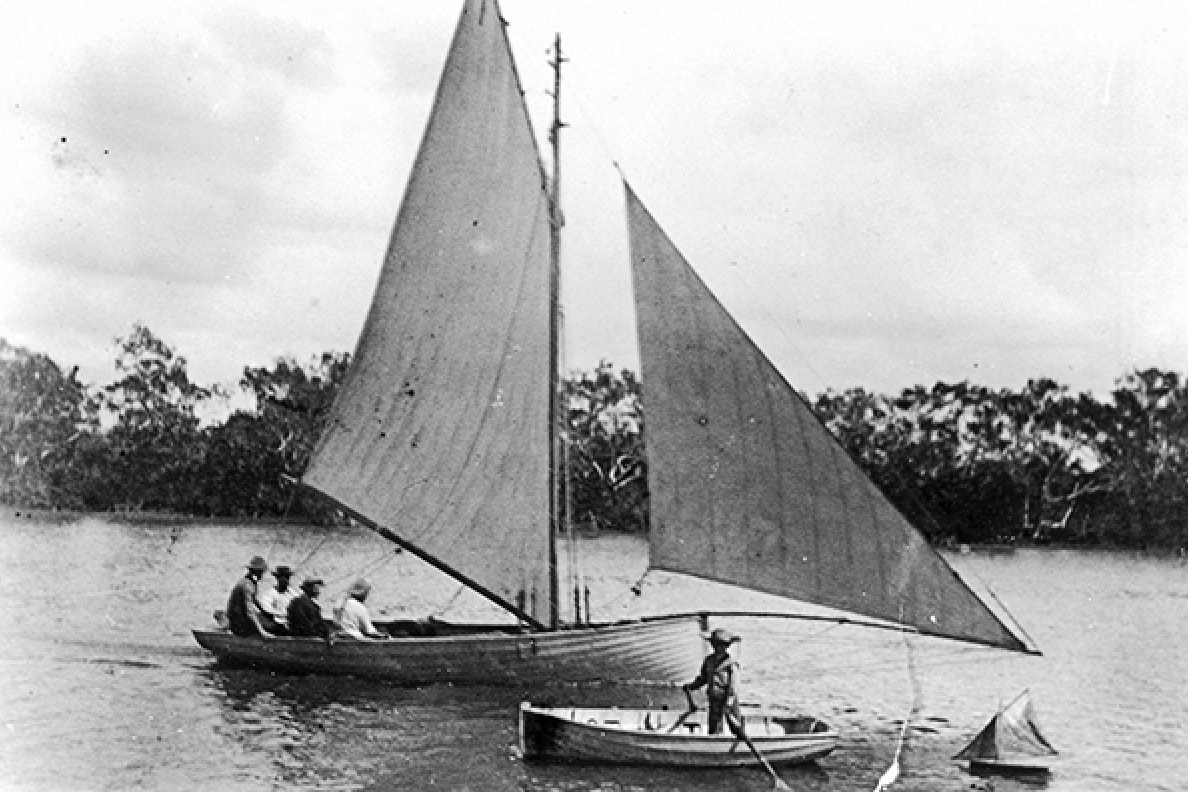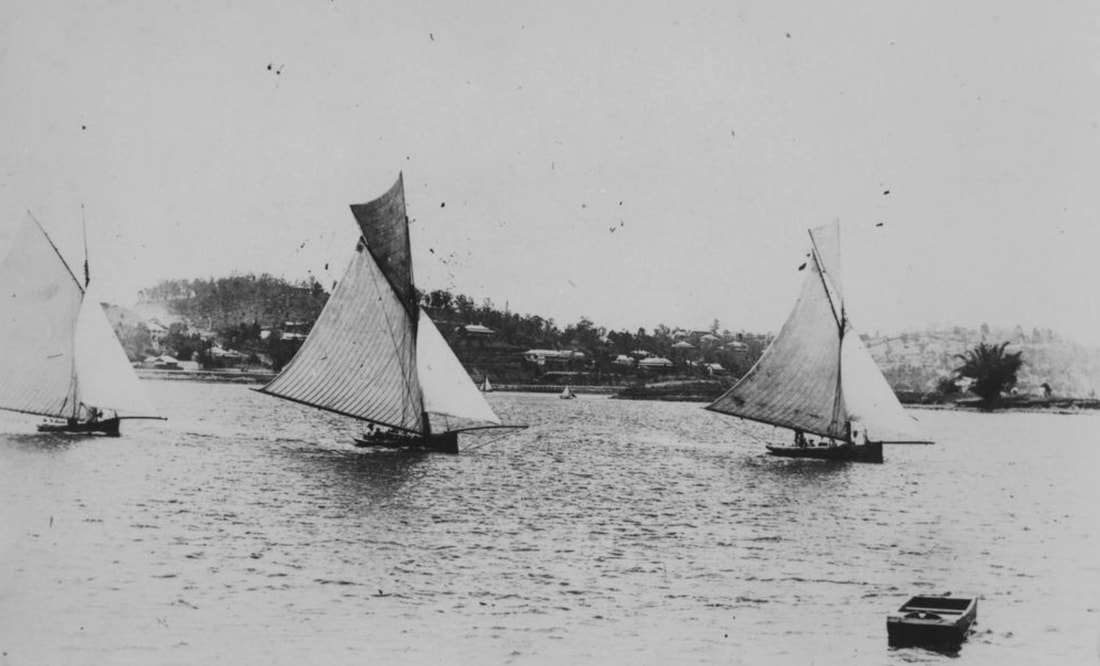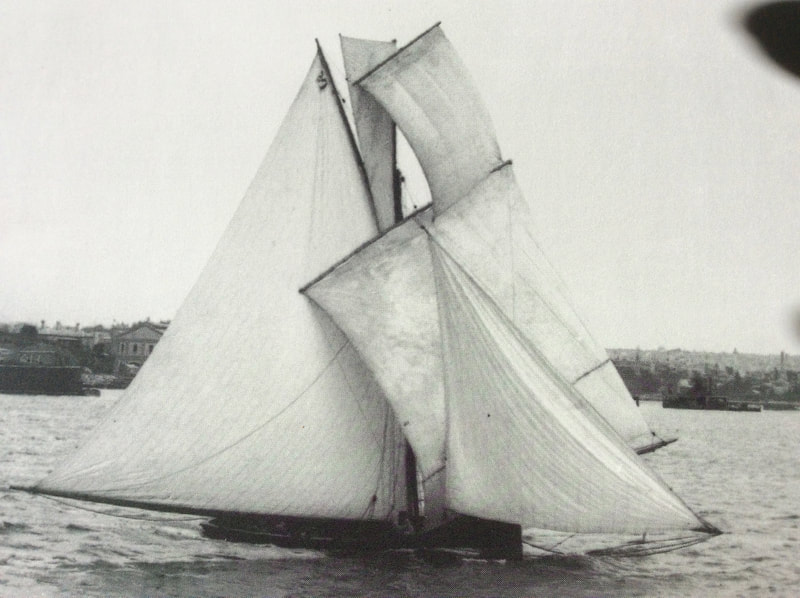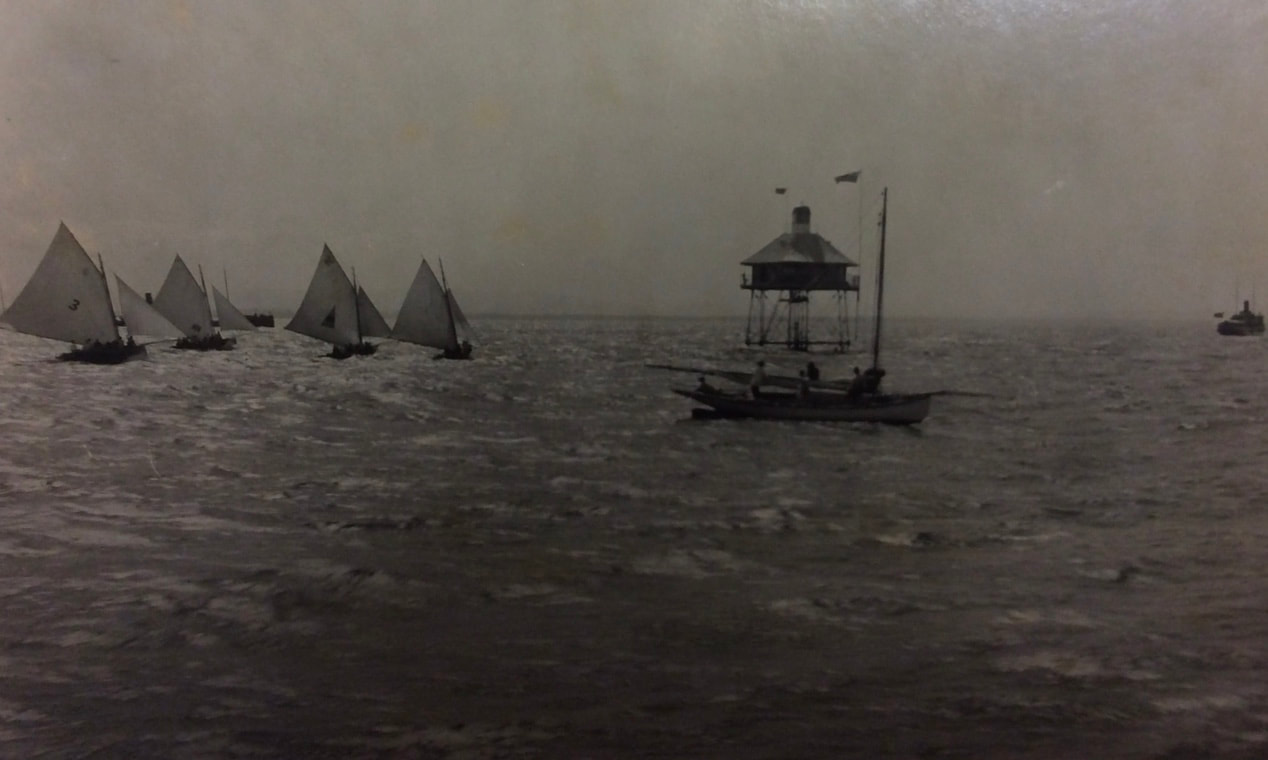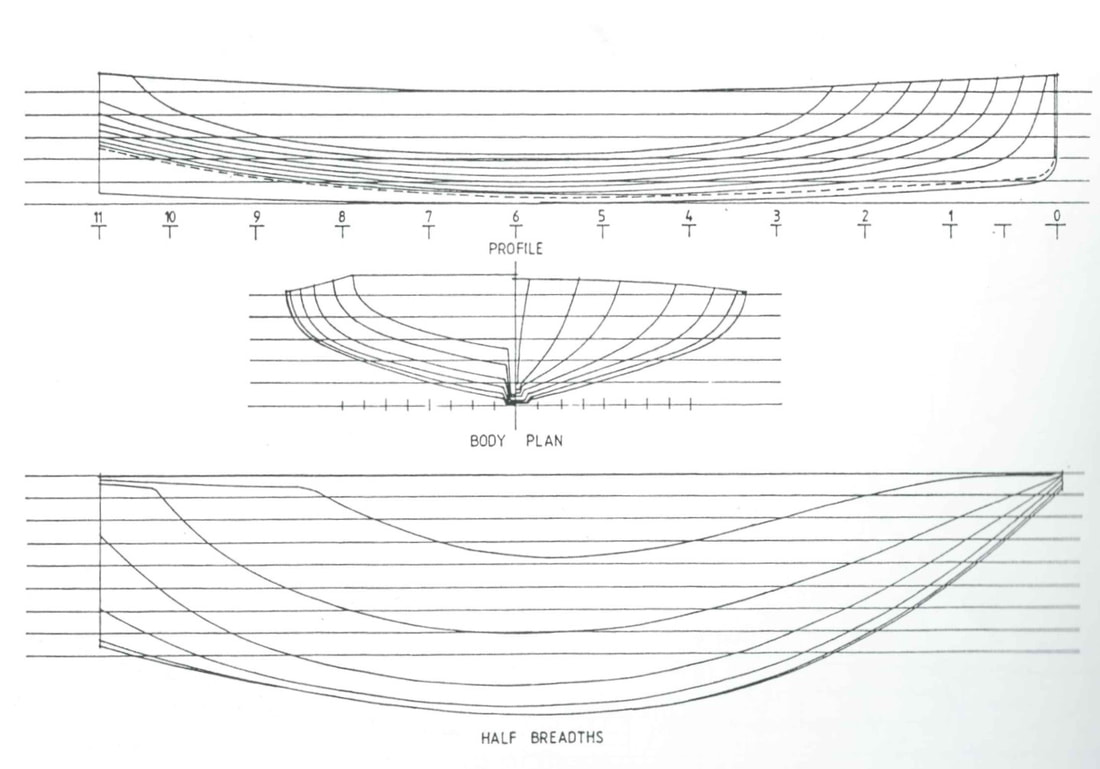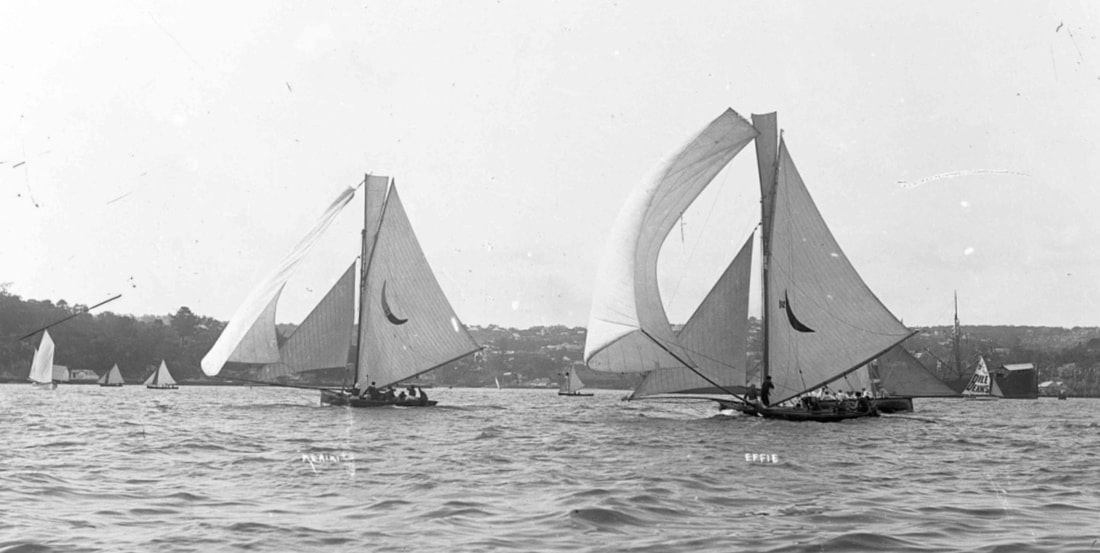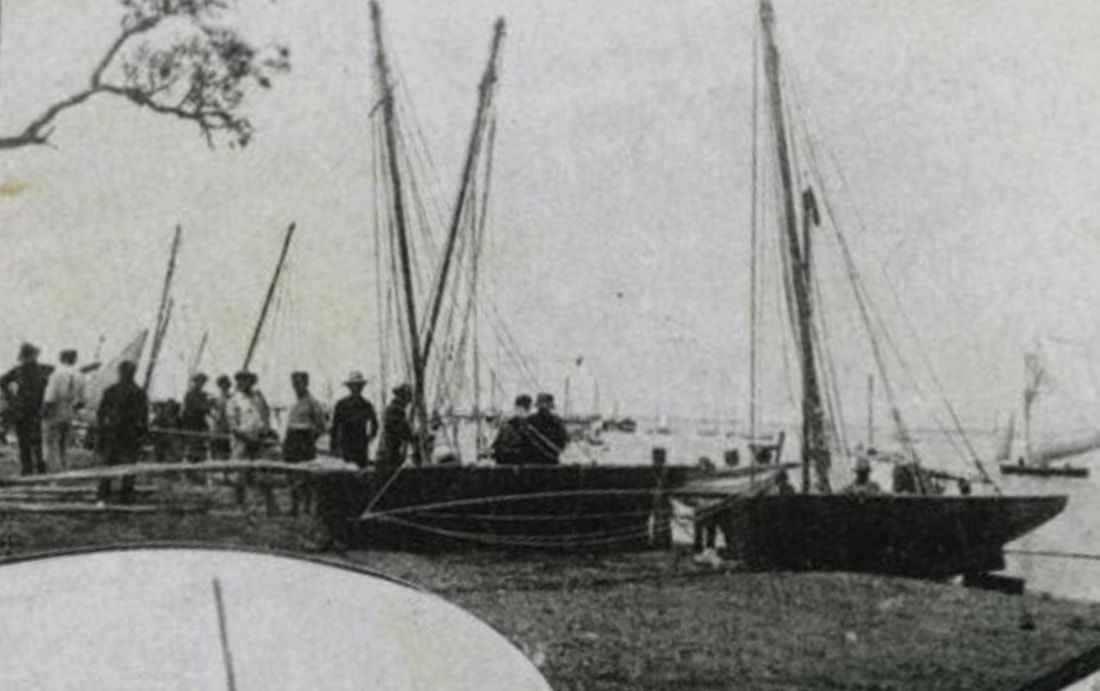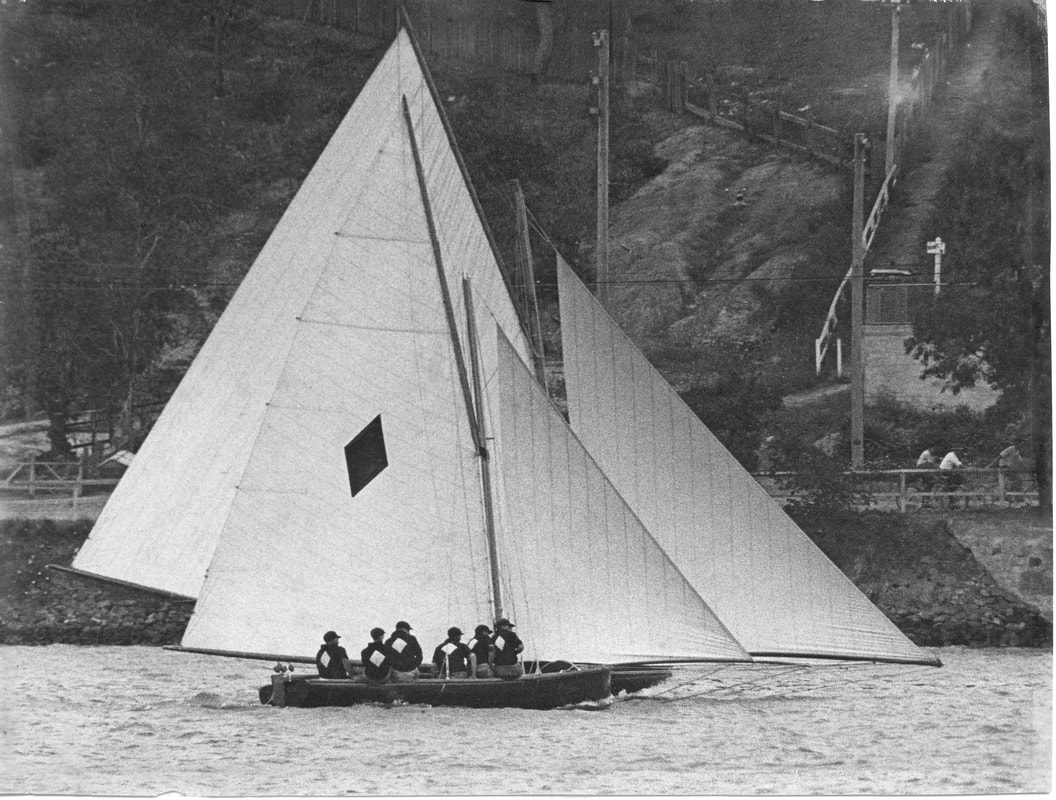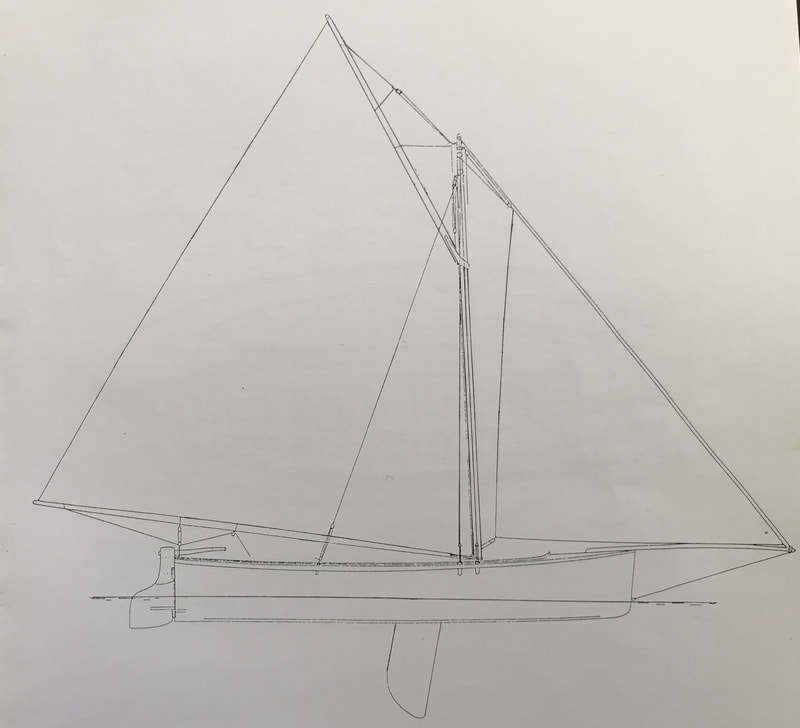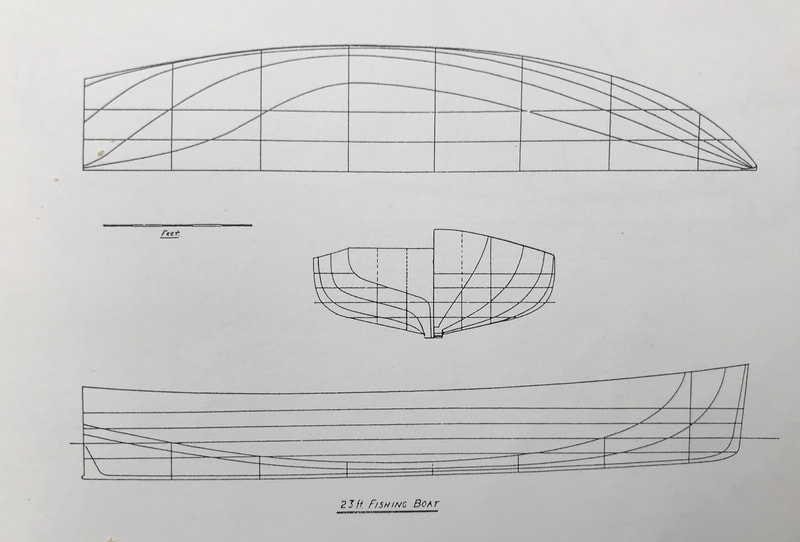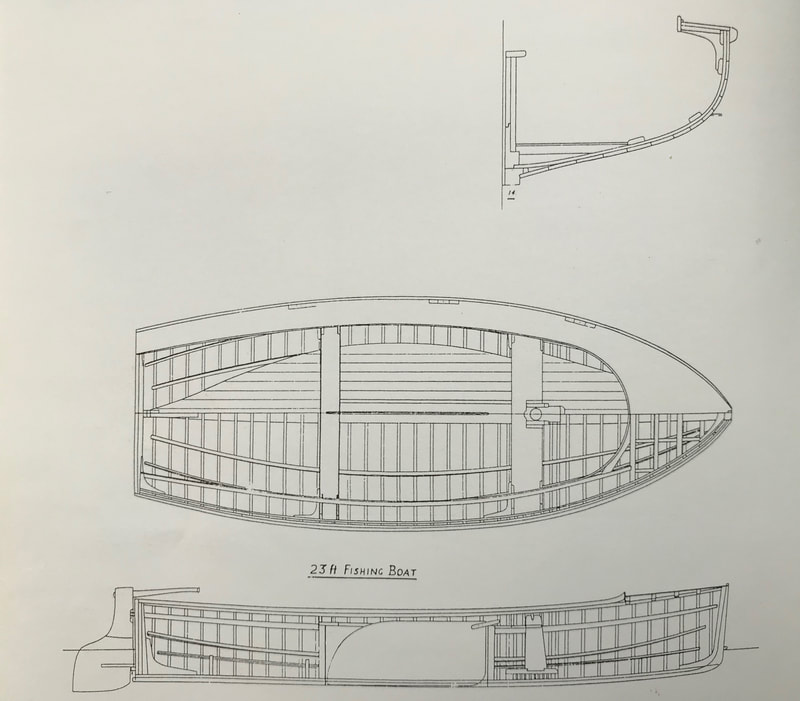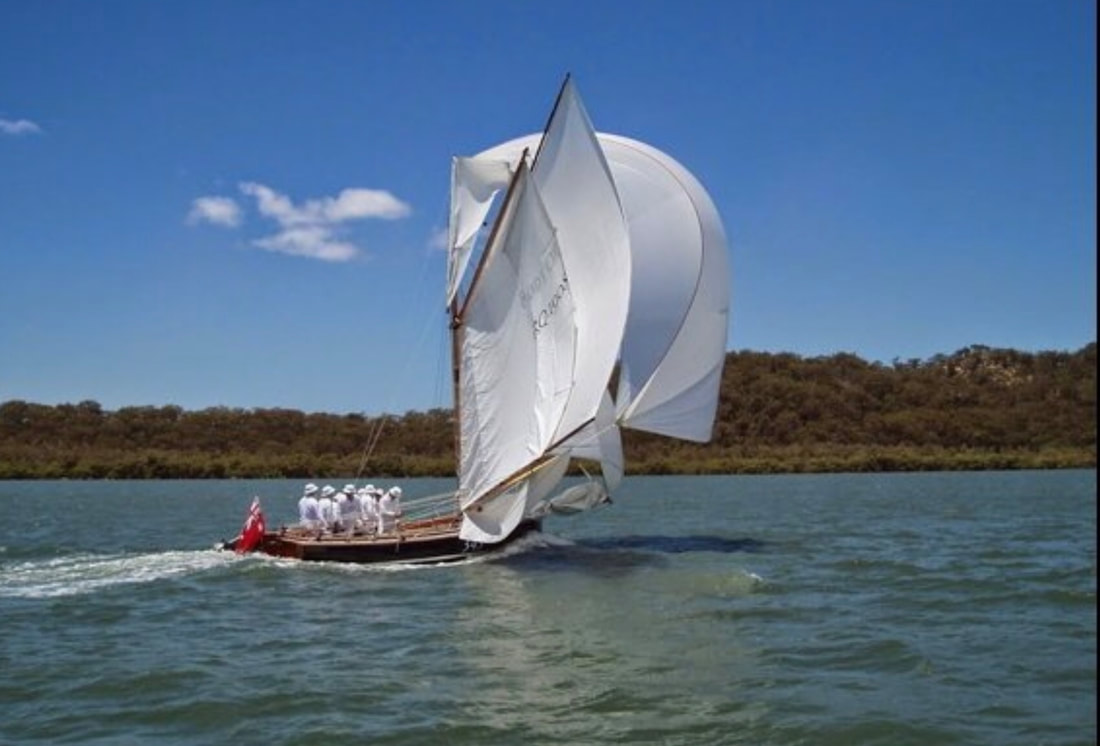This yarn is based on a talk I gave to the Royal Queensland Yacht Squadron's 42 Club (for those who have been members for over 42 years) in October 2019.
In the last two decades of the 19th Century, Brisbane, being a smaller population centre than Sydney, didn’t have a large number of boats nor the wide range of racing classes of open boats found in the senior city. There was one club, the Brisbane Amateur Sailing Club which evolved through several name changes into the Royal Queensland Yacht Squadron, which held fairly regular races on the River from 1885, and several outlying regattas, mostly held on parts of Moreton Bay such as the Humpybong Regatta, the Southport Regatta and the Sandgate Regatta. All featured races for boats of 22 feet and under from 1884.
A typical Moreton bay fishing or oyster boat of the late 19th Century. This one belonged to the Tripcony family in the oyster business, and looks to be about 18-20', but the early 22-footers were similar in style, generally clinker-built.
Twenty-two feet must have been a common size, because although there were a minority of boats entered that were 20’ and 21’, the majority were 22’. At this point I believe none were built specifically for racing, they were fishing and oyster boats that worked the extensive shallow waterways of Moreton Bay. Some were carvel-planked (edge-butted planks with caulking cotton in the seams) but the majority were clinker-planked (overlapping planks). They were ballasted with railway iron below level floorboards, were painted inside and out, and kept afloat. At least some had copper sheathing below the waterline. A newspaper commented in 1885 that the 22’s were “now always the feature of our sailing regattas”. In January 1886 the class was described as being about 7’ beam, 2’9” in depth, and half-decked, and usually raced with 9 crew. They carried balloon jibs and squaresails for off-the-wind work.
Unidentified 22-footers racing on the Brisbane River, about 1890. Just one club, the Brisbane Amateur Sailing Club, which evolved into the Royal Queensland Yacht Squadron, existed at this time.
Pretty early on, boats began to be built specifically for racing. There were several local builders favoured, but Brisbane Amateur Sailing Club member George Markwell ordered a boat built by Billy Golding in Sydney. Nyoola (22’x7’ beam) was delivered in April 1886 and began to win races. In 1887 Yapina was built on novel lines, modelled after the US Sandbaggers (see YARN on SANDBAGGERS AND 18-FOOTERS). In 1888 local builder Monteith copied Nyoola to build Wanetta for T.Goodall but widened her to 9’ beam, along the lines of what was happening to the Sydney open boats at that time (see Chapter 3 of The Open Boat book). Champion helmsman Jack Whereat commissioned ex-Sydney, now local builder J McCleer to build Bulletin (9’ beam by 2’8” depth), but Billy Golding always claimed he had sold him the moulds. Golding certainly was popular in Brisbane, in 1891 T.Goodall had him build Caneebie (9’6”x 3’). Mr Wain went to Sydney’s go-to yacht designer for a 22-footer which was built for him by W.Warbrick and was named Clyanthus.
Early Brisbane 22's built just for racing, Nyoola, Clyanthus and Bulletin.
The new boats were way faster than the older fleet. They were varnished inside and out, kept ashore and sailed with reduced or no ballast, relying on larger crew numbers. They were all built batten-seam carvel (where each plank seam is not caulked but backed up with a batten to which the planks are nailed). The older boats which were mostly clinker-built were outclassed and began to demand their own races at Regattas, and sometimes allowances when racing in the same fleet.
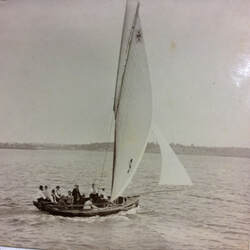
Caneebie, one of Brisbane's most successful 22-footers. Photo Golding scrapbook, ANMM.
Sydney also was developing a fleet of 22-footers at the same time, even though the Sydney 24’ class was dominant, attracting the most prize money and attention at Regattas. In 1894, T.Goodall proposed to Billy Golding that Sydney should send up a few 22’s to challenge the Brisbane boats, and so the first Intercolonial Challenge event took place in March 1894. The whole story of the Intercolonial Challenges up until 1899 is told on the YARNS Page in THE INTERCOLONIAL CHALLENGES OF THE 1890’s, but in summary the first was conducted over 2 races, the first won by Sydney boat Irex and the other by Queensland boat Bulletin. The contests took place alternately in Sydney and Brisbane, and for the first two years honours were relatively evenly divided between the colonies, but in the third year (1895-96) Brisbane boats won all four races.
The 1895-96 fleet at the Pile Light on Moreton Bay. Brisbane boats had a clean sweep of all four races this season. Photo Golding scrapbook, ANMM.
The lines of an unidentified 22-footer drawn by Bill Bollard from a model in the Brisbane Maritime Museum. The beam on this boat is almost 11 feet.
This stimulated Sydney owners to build more new boats, and Vigilant, Figtree and Effie appeared for the next challenge in Sydney. However the Championship race was won by the old Sydney boat Irex. The elderly Queenslander Bulletin won another, and in the two other races one was won by the new Sydney boat Vigilant and one by Mark Foy’s catamaran Flying Fish (see YARN under that name).
But the new Sydney boats came into their own for the fifth series in Brisbane in 1897-98 when in four races Effie won three, and the other was won by Irex, making a clean sweep for Sydney. It was worse in the sixth series in 1898-99 when Queensland boats could not get a single place in multiple races in fleets of 22’s, 18’s, 14’s and 10-footers.
But the new Sydney boats came into their own for the fifth series in Brisbane in 1897-98 when in four races Effie won three, and the other was won by Irex, making a clean sweep for Sydney. It was worse in the sixth series in 1898-99 when Queensland boats could not get a single place in multiple races in fleets of 22’s, 18’s, 14’s and 10-footers.
Two of the greatest Sydney 22-footers, Keriki and Effie. Effie won 3 out of 4 races in the second-last Intercolonial Challenge in 1897-98 and 2 out of 3 in the last Challenge in 1898-99.
This broke the hearts of the Queenslanders, and no enthusiasm could be found for continuing the series. Brisbane Regattas found it hard to attract enough 22’s to have a race in the next few seasons, and without the impetus of the Intercolonials, the Sydney fleet began to fade as well. The rise of the 18-footers as a popular class assisted in this decline of the 22’s. By 1902 the 18’s were the dominant class in terms of numbers, prize money and public attention in both cities.
Eighteen-footers at the Humpybong Regatta, early 1900's. The 22's had had their day, and the 18's were the dominant class.
Western Australia took over as the main rival to Sydney in Interstate competition up until the First World War, but Brisbane came back after the War with Queensland 18-footer Vision winning the Australian Championships of 1920-21 in Sydney and 1922-23 in Brisbane.
Brisbane also began to dominate in the new class of restricted 16-footers after the War. Jack Whereat’s son Toby was a boatbuilder and Champion 16-footer sailor for several years in a row in the late 1920’s in his 16’ Aberdare, partly due to his pioneering of eliminating the heel or skeg. In 1932 he built an 18-footer along 16-footer lines, named it also Aberdare and it began to win races (though not with Toby as he died of pneumonia but lived long enough to see his boat winning). Aberdare won four Australian Championships in a row and was the catalyst in the split in the Sydney fleet that you can read about in The Open Boat book or Robin Elliott’s Galloping Ghosts, and a long period of dominance of innovation and design by Brisbane builders, and domination of Interstate racing by Brisbane crews.
Aberdare over Tangalooma, the new and the old, showing the lighter skiff-type rig and hull that ended the dominance of the big-beam, big sail 18's.
What happened to all the old 22’s? Several Sydney boats raced on, Plover up until 1907, Keriki until 1913. Several others appeared occasionally in minor Club racing. Many Queensland boats went back into fishing. Brisbane boat Zenobia, one of the beamiest at 12’ was wrecked in a storm off Caloundra in 1897 with 5 drowned. Bulletin was sent North and was wrecked in a gale off Bowen in 1916. Caneebie may have ended up in Sydney, a 22-footer of that name was entered in a general handicap in the Anniversary Day Regatta in 1913.
Moreton Bay fishermen continued to use this type of boat at least until motors became more available after WWI. In fact new boats were still built. The images below are of Stafford, a 23' fishing boat built by Norman Wright Senior in about 1905, optimised for load carrying rather than racing. This plan was used by Chris Tyquin to build Boxer, which many of you will have seen around Moreton Bay and at more than one Australian Wooden Boat Festival in Hobart.
